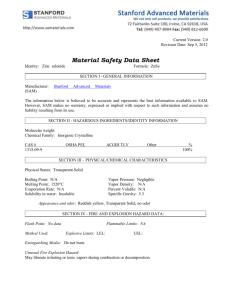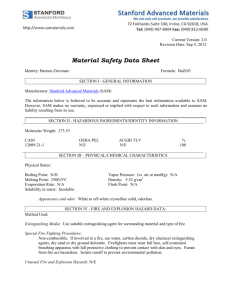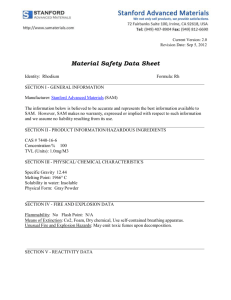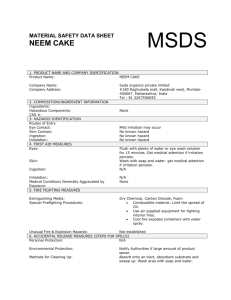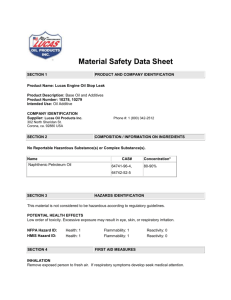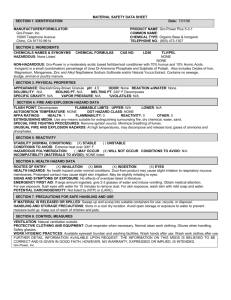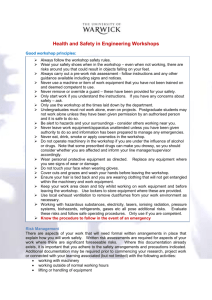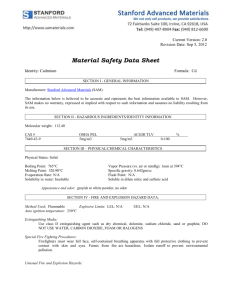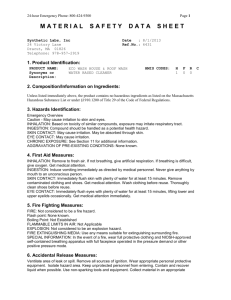Microsoft Word - Pb - Stanford Advanced Materials
advertisement
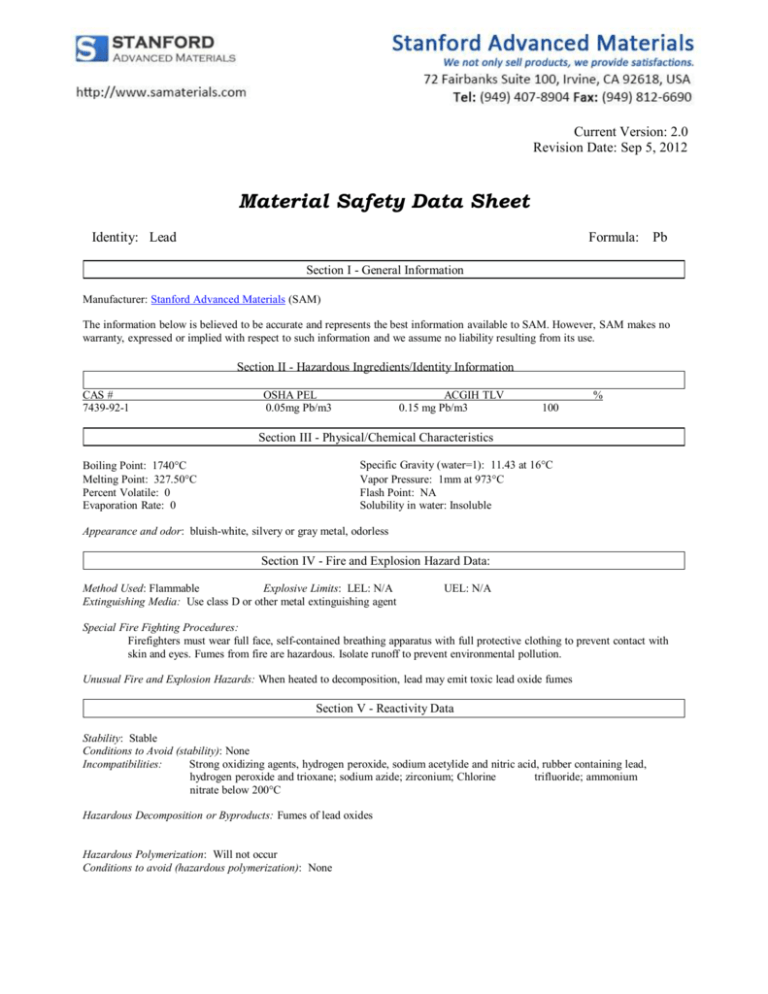
Current Version: 2.0 Revision Date: Sep 5, 2012 Material Safety Data Sheet Identity: Lead Formula: Pb Section I - General Information Manufacturer: Stanford Advanced Materials (SAM) The information below is believed to be accurate and represents the best information available to SAM. However, SAM makes no warranty, expressed or implied with respect to such information and we assume no liability resulting from its use. Section II - Hazardous Ingredients/Identity Information CAS # 7439-92-1 OSHA PEL 0.05mg Pb/m3 ACGIH TLV 0.15 mg Pb/m3 % 100 Section III - Physical/Chemical Characteristics Specific Gravity (water=1): 11.43 at 16°C Vapor Pressure: 1mm at 973C Flash Point: NA Solubility in water: Insoluble Boiling Point: 1740C Melting Point: 327.50C Percent Volatile: 0 Evaporation Rate: 0 Appearance and odor: bluish-white, silvery or gray metal, odorless Section IV - Fire and Explosion Hazard Data: Method Used: Flammable Explosive Limits: LEL: N/A Extinguishing Media: Use class D or other metal extinguishing agent UEL: N/A Special Fire Fighting Procedures: Firefighters must wear full face, self-contained breathing apparatus with full protective clothing to prevent contact with skin and eyes. Fumes from fire are hazardous. Isolate runoff to prevent environmental pollution. Unusual Fire and Explosion Hazards: When heated to decomposition, lead may emit toxic lead oxide fumes Section V - Reactivity Data Stability: Stable Conditions to Avoid (stability): None Incompatibilities: Strong oxidizing agents, hydrogen peroxide, sodium acetylide and nitric acid, rubber containing lead, hydrogen peroxide and trioxane; sodium azide; zirconium; Chlorine trifluoride; ammonium nitrate below 200°C Hazardous Decomposition or Byproducts: Fumes of lead oxides Hazardous Polymerization: Will not occur Conditions to avoid (hazardous polymerization): None SECTION VI - HEALTH HAZARD DATA Health Hazards (Acute and Chronic): Inhalation: May cause insomnia, depression, dryness of the mouth, nausea Ingestion: May cause constipation and abdominal pain, colic, tremors, nausea, , vomiting, diarrhea, metallic taste, loss of appetite, irritability and muscle pain, uncoordinated muscle movements, coma and death. May also cause anemia, gingival lead line, paralysis in the wrist and permanent neurological injury, and/or scarring and shrinking of the kidney tissue Skin: May cause redness, itching and burning Eye: May cause redness, itching, burning and watering Target Organs: May affect gastrointestinal tract, central nervous system, kidneys, blood, skin and gingival tissue Carcinogenicity: NTP? No IARC Monographs? No OSHA Regulated? No Medical Conditions Aggravated by Exposure: Pre-existing lung and circulatory disorders Emergency and First Aid Procedures: Inhalation: Remove victim to fresh air, keep warm and quiet, and give oxygen if breathing is difficult; seek medical attention Ingestion: Give 1-2 glasses of milk or water and induce vomiting, seek medical attention. Never induce vomiting or give anything by mouth to an unconscious person Skin: Remove contaminated clothing, brush material off skin, wash affected area with mild soap and water, and seek medical attention if symptoms persist Eye: Flush eyes with lukewarm water, lifting upper and lower eyelids for at least 15 minutes and seek medical attention SECTION VII - PRECAUTIONS FOR SAFE HANDLING AND USE Steps to be taken in case material is released or spilled: Wear appropriate respiratory and protective equipment specified in section VIII. Isolate spill area, provide ventilation and extinguish sources of ignition. Vacuum up spill using a high efficiency particulate absolute (HEPA) air filter and place in a closed container for proper disposal. Take care not to raise dust. Waste disposal method: Hazard Label Information: Dispose of in accordance with state, local, and federal regulations. Store in cool, dry area and in tightly sealed container. Wash thoroughly after handling. SECTION VIII - CONTROL MEASURES Protective Equipment Summary (Hazard Label Information): NIOSH approved respirator, impervious rubber gloves, safety glasses, clothes to prevent contact. Ventilation: Local Exhaust: To maintain concentration at low exposure levels. Mechanical (General): NOT Recommended. Work/Hygienic/Maintenance Practices: Implement engineering and work practice controls to reduce and maintain concentration of exposure at low levels. Use good housekeeping and sanitation practices. Do not use tobacco or food in work area. Wash thoroughly before eating or smoking. Do not blow dust off clothing or skin with compressed air. Please be advised that N/A can either mean Not Applicable or No Data Has Been Established

